#postwar and contemporary artist
Photo
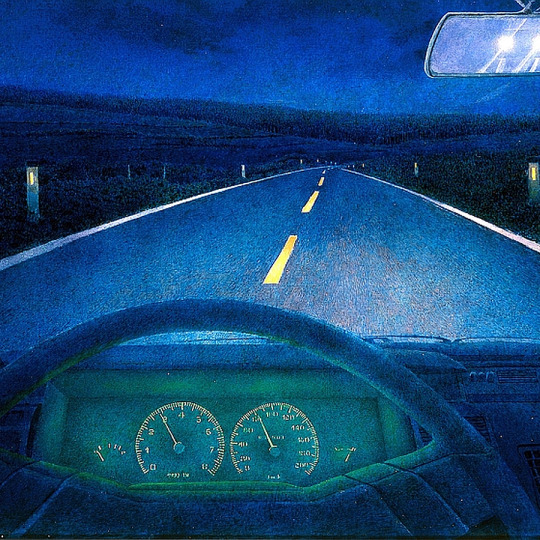




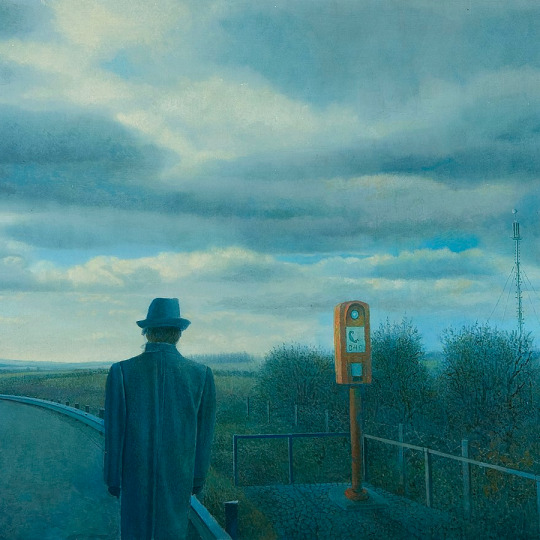

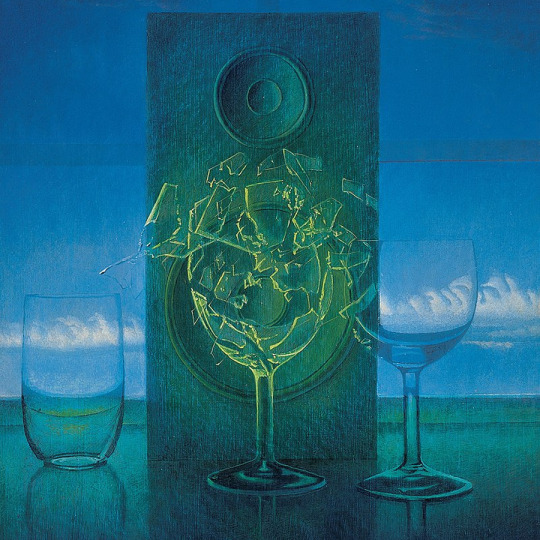

Artist I Like Series
Hanno Karlhuber 1946 - 2022 an Austrian painter known for his magical realism paintings.
#Hanno Karlhuber#contemporary art#postwar art#male artist#painter#austrian#20th century art#21st century art#artist I like#art history#art#art inspo#fave#petal talks
26 notes
·
View notes
Text

John Lees
"I'm playing out my fantasies in paint..."
John Lees' words in the New York Studio School seminar of Painting and Meaning kinda threw me off. He then continued to talk about fantasies of being a musician, a writer, a "frustrated sculptor", but that he had to express those desire through painting as he says, "it's all I'm really good at."
John Lees was born in 1943 in Denville, New Jersey, and grew up in Los Angeles. He received his BFA and MFA from the Otis Art Institute in Los Angeles (now Otis College of Art and Design). He has been exhibiting in New York since 1977 and has been an instructor at the New York Studio School since 1988. His work is represented in the collections of the Detroit Institute of Arts, Detroit, Michigan; the Fogg Art Museum, Cambridge, Massachusetts; the Kemper Collection, Kansas City, Missouri; the Orange County Museum of Art, Newport Beach, California; the Museum of Modern Art, New York; and the New Museum, New York. He is represented by Betty Cuningham Gallery, New York, where he has been the subject of several solo exhibitions, most recently in March to May 2021. (hyperallergic.com)
I don't think John Lees has his own site (don't confuse with W. John Lees), but here's a lovely interview with him that provides more of a detailed history and discusses his work's relationship with time in much more depth
https://hyperallergic.com/738680/beer-with-a-painter-john-lees/
#john lees#postwar painting#contemporary painting#american painting#2020s#70s#80s#90s#art resource#glory on the artist
0 notes
Text

Luke Butler. Landing Party II, 2010.
acrylic on canvas
1 note
·
View note
Photo

Wojtek Kowalczyk is a Polish Postwar & Contemporary artist who was born in 1960.
Wojtek Kowalczyk
711 notes
·
View notes
Text

Interesting, artsy 1980 home in Taos, New Mexico has 8bds, 4ba, $1.259M. The property contains a main house, resembling a ship, with four rentals, "casitas," vegetable gardens, a workshop, chicken coop, and meditation trails to the river. It was started in 1980 by the American Postwar & Contemporary artist, Malcolm McCleod Brown (1925-2003), and completed by his family and the current owner.
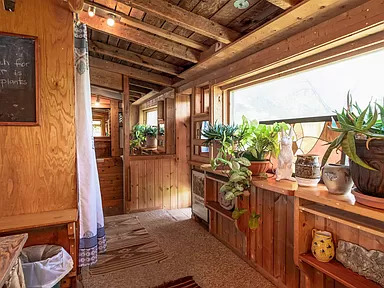
It's a very organic home.

All wood.

The kitchen is small, but nice. Very artsy and hand crafted.
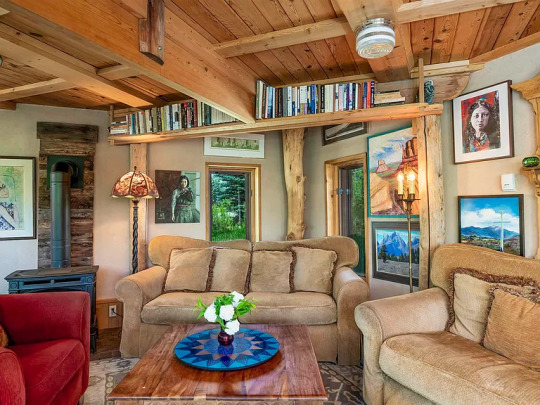
Cozy living room.

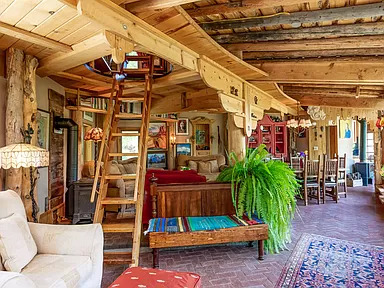
Ladder to a loft above.

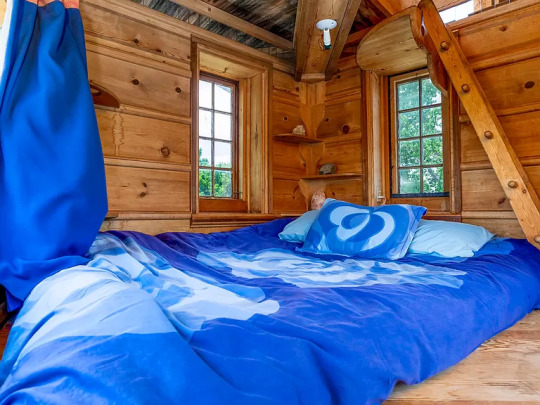
Bed and small sitting area in the loft.
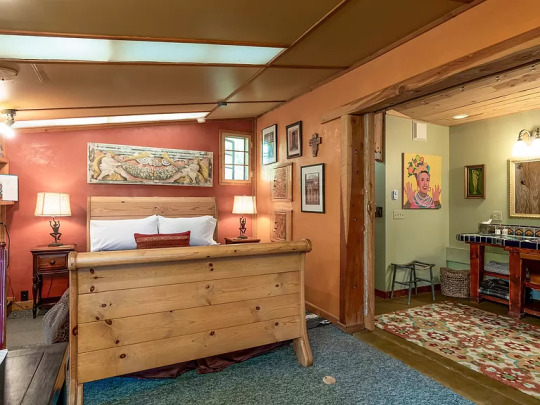

Bedroom and a colorfully tiled bath, as is typical in a Mexican style home.

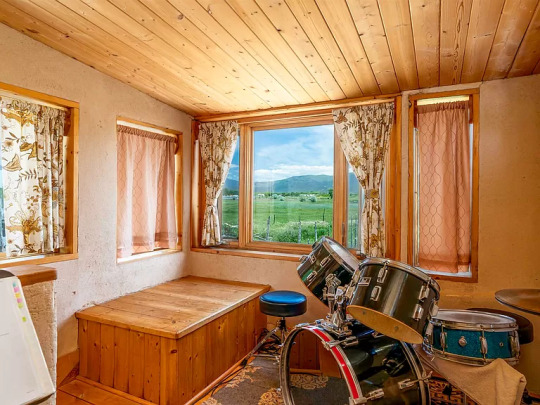
Another bedroom in the main house.
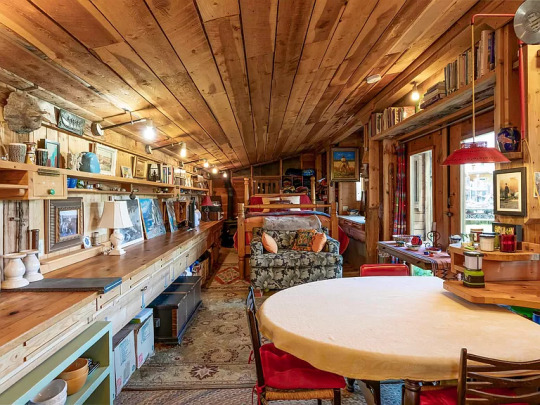
I think that this is one of the casitas.
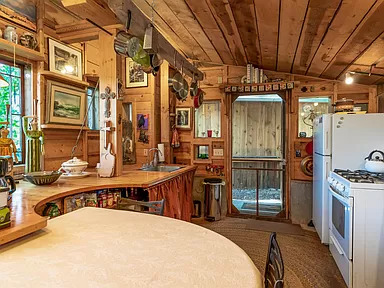
Cute kitchen.

Approaching the 3 acre property.


There appears to be a casita on the roof. I like the tower. Wish they would've shown the interior.

A garden is set up in this area.


This also looks like a large farm area.


Lots of space.

One of the casitas.

This also looks like one of the rental buildings. It's been on Airbnb.

The buildings were put together with recycled materials.


It's an interesting home.
https://www.zillow.com/homedetails/627-Boyer-Ln-Taos-NM-87571/102030922_zpid/
124 notes
·
View notes
Text

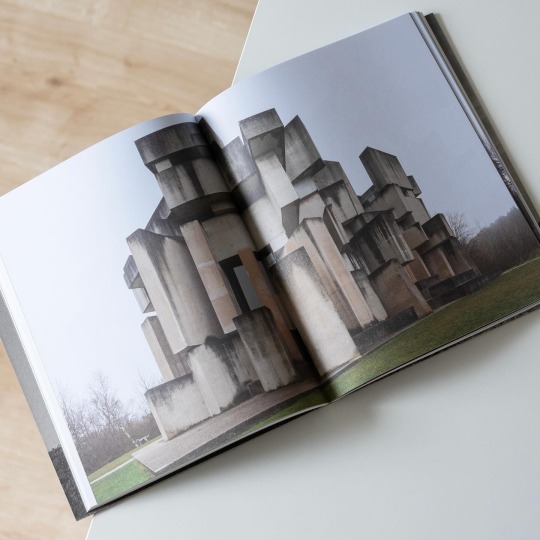
Almost 50 years after its consecration Fritz Wotruba’s Church of the Holy Trinity in Vienna still remains one of the most fascinating church buildings of the 20th century. Made up of 152 individually cast concrete blocks it is a puzzling structure oscillating between architecture and sculpture, the open and the closed. In 2021/22 the Belvedere21 in Vienna with „Wotruba. Himmelwärts - Die Kirche auf dem Georgenberg“ dedicated an entire exhibition to the building, its creator and the conflictual genesis of it. It was accompanied by the present and highly insightful catalogue published by Verlag der Buchhandlung Walther und Franz König that on the one hand recounts the protracted and conflict-laden history of the church but on the other hand also locates it within postwar church architecture and Wotruba’s oeuvre. Within the latter it marks a high point that crowns a development towards dissolving the figure in an architectural form and more than a decade of continued dedication. Sadly Wotruba didn’t see the completion of the church as he untimely died in 1975. Besides a highly insightful exegesis of the church the catalogue also contains a wealth of drawings and contemporary photographs that document the coming to life of the building on site and in the artist’s imagination, a deeply fascinating process that nonetheless was very critically and at times even hostilely received by both the public and the expert audience. The waves have calmed over the past four and a half decades and Wotruba’s church now ranks among the relevant sites to see in Vienna, a development that the Belvedere’s exhibition will further contribute to as it deepens the understanding of and hopefully also the love for this unique church.
55 notes
·
View notes
Text
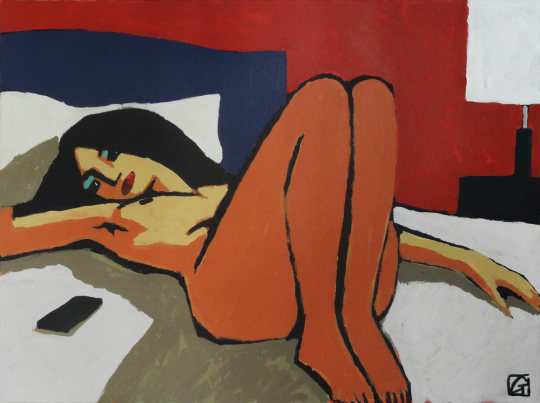
JC Götting (Jean-Claude Götting) / b. 1963 French Postwar & Contemporary artist
152 notes
·
View notes
Text
Daydream Generation: The Lasting Legacy of Akira Toriyama's Work
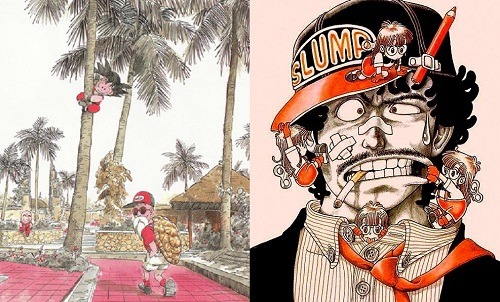
Here on AcquiredStardust we don't talk about anime enough and we wish that beginning to rectify this could've come under better circumstances. Just what is the Daydream Generation anyway? Join Ash as she attempts the impossible task of summarizing the importance of the 'god of manga' Akira Toriyama after his passing earlier this month in this special tribute.
Late Thursday night news finally broke on social media that beloved manga author Akira Toriyama had passed away several days before, prompting an immediate outpouring of grief the world over. Many of us feel a deep sense of loss in a way unimaginable before his work achieved the level of cultural penetration and ubiquitous veneration that it has, and it is impossible to overstate the singular importance he had in shaping our modern culture.
Responsible for hit manga Dr. Slump and Dragon Ball which quickly found themselves at the forefront of the Japanese pop culture renaissance of the Showa period, Toriyama's work is possessed of a rare combination of an earnest childlike wonder and adventure that is perfectly serviced by an instantly recognizable art style that is something of a rite of passage to for budding artists to imitate. It is in that Showa boom period that the Daydream Generation, a term coined by Toriyama disciple Yoshihiro Togashi's Yu Yu Hakusho particularly as the title of its 5th ending theme, is forged.
It is no overstatement to refer to Akira Toriyama as "the god of manga", and in fact he is referred to as such by Masashi Kishimoto of Naruto fame. It is Kishimoto's generation, coming of age in the Showa era in which Toriyama produces his most significant works, that finds themselves first so captivated by it. Although anime is in the middle of a golden age by the time Toriyama's work is published (lead perhaps most by Leiji Matsumoto of Galaxy Express 999/Captain Harlock fame and Mobile Suit Gundam visionary Yoshiyuki Tomino), Toriyama's work forges a connection with Japanese readers in a way that other work hasn't quite in the same way.
Perhaps it is the clean linework, deceptively simplistic and stylish all at once. Perhaps it is the expressive characters often named with clever puns or food related names. Perhaps it is familiar cultural touchstones and elements of comedy and parody rolled seamlessly into each other. Perhaps it is the refinement in elements popularized by contemporary works like Ring ni Kakero such as the frequent use of tournaments as a framing for the plot Perhaps it is the rare ability for Toriyama to create characters that often appeal equally to male and female readers without either demographic rejecting them, feat only rivaled with any real frequency by authors Rumiko Takahashi and Hiromu Arakawa.
Regardless of the cause, the strong creative voice and earnestness that shines through Dr. Slump and Dragon Ball does something special for children of the Daydream Generation: it makes the job of creating manga seem more attainable than other works of the time do. It gives a generation of children the ability to dream, some for the first time, of their own works. It is in the immediate wake of these works that authors such as Masashi Kishimoto, Yoshihiro Togashi, Tite Kubo and Eiichiro Oda come of age and dream of their own works in direct inspiration from them.
The Daydream Generation, sat in their desks at class fantasizing about a world in which they too would be able to pursue creative dreams in a postwar Japan perhaps otherwise unattainable to them without first being armed with the sense of accessibility that Toriyama provided readers, affectionately refer to Toriyama as 'sensei' nearly universally. It is he who is the god of manga, revered and emulated - Toriyama, more so than any individual, is responsible for the explosion of Japanese pop culture in this era and many manga authors are frank in their admittance of such. It isn't just limited to the world of manga either, as Toriyama has a hand in multiple iconic video games such as Enix's Dragon Quest and Square's Chrono Trigger.
But then something equal parts special and unlikely happens: in the late 1990s Toriyama's work begins to be exported into the west with relatively minimal changes to the source material, and the whole process repeats itself. This time with a constant flow of follow up works by the Daydream Generation to help Japan's global pop culture takeover.
Anime's infiltration into the west played out on college campuses, and in those early days of fandom defined by import VHS and LaserDisc it was nearly unthinkable that it would end up mainstream enough to appear on television. While early ground is gained on anime in the mainstream (particularly Ronin Warriors hitting television in a largely unedited form in 1995 as well as multiple attempts to import Sailor Moon around the same timeframe, not to mention Pokemon's debut in late 1998), it is not until the revamping of Cartoon Network's Toonami block, spearheaded by Dragon Ball Z, that anime would truly arrive in the west.
The importance of Toonami in getting anime in front of the eyes of the generation following the Daydream Generation in America cannot be overstated. It was the first time many of us laid eyes on animation that wasn't an episodic comedy, with more mature themes. It was the first time we had encountered drastic cultural differences inherent in anime. For many of us, particularly in the case of Dragon Ball Z, it was even the first time we began to see animation and even creativity as being something that comes from someone rather than spontaneously generating itself for consumption. For the first time in my memory a mania kicked off with the addition of Dragon Ball Z to Toonami in 1999 that changed the way my generation thought about and consumed media.
Gathered around our own desks ten plus years later, American children male and female alike passionately discussed Dragon Ball Z. We debated power levels, questioned what other planets and races populated the universe of the series, and for the first time we discussed concepts that were unknown to us just a short time before: who was the creator of this series and where did it come from? Mirroring the effect that Toriyama's work had on the Daydream Generation many Milennials and Gen X people, especially those with no prior introduction to anime, found themselves absolutely captivated by Dragon Ball Z. Millions of young people put pencil to paper for the first time to imitate the art style of Toriyama brought to animated glory by the staff at Toei or to write fanfiction. We developed these skills and collaborated with each other now armed with the same sense of approachability that the Daydream Generation had years before us. And then the hits kept coming.
Serving as a gateway into a world of animation previously largely unknown in the west, Toonami exploded in the following years.
Starting in 2000 Toonami added Tenchi Muyou, a series almost completely different to Dragon Ball Z which would go on to be an influence in Dana Terrace's recent Disney hit The Owl House, and Mobile Suit Gundam Wing. The Gundam franchise, originally popular in Japan contemporaneously with Akira Toriyama's work, had seen many followups and spinoffs in the years after the original series ended and had itself become a titan of Japanese pop culture. Finally hitting the west using Dragon Ball Z as a bridge, it was the first time many of us were introduced to animation as a medium for communicating complicated political ideas.
Perhaps most significantly, as is easily observed through diving into the wealth of old abandoned websites from the Geocities era, Gundam Wing served as a vehicle through which young people were introduced to male characters that all seemed to have romantic chemistry with each other. Having both lived through the era and examining it in retrospect I say with all sincerity that it was Gundam Wing that helped begin the yaoi craze in the west, by then a well established thing in Japan, and was therefore absolutely instrumental in beginning to soften the attitudes of young people towards queer people in the west.
A strong hunger for more of this extremely different kind of animation had been created and the floodgates were about to open. Years immediately following saw the broadcast of memorable anime such as Outlaw Star and The Big O. 2003 saw Nobuhiro Watsuki's unavoidably Japanese historical fiction piece Rurouni Kenshin debut in America, Yoshihiro Togashi's Yu Yu Hakusho finally make the transition to the west followed by Eiichiro Oda's One Piece and Masashi Kishimoto's Naruto in 2005. Each of these works massively impacted my generation and empowered us in a different way: whereas the Daydream Generation saw the opportunity to create their own works my generation had the luxury of exploring these works, full of ideas and states of being unknown to us before then. We were armed with the ability not just to create our own works but to create ourselves and to decide who we would be far more liberally than we would have otherwise been comfortable doing in the past.
It is worth noting that Toonami did not have total dominion over the boom of anime in America: while there were others in later years, latenight programming [Adult Swim] pursued an older viewer who was hungry for even more of what the wide world of anime had to offer. Rumiko Takahashi's Inuyasha was an early favorite alongside the likes of such classics as Cowboy Bebop, Trigun and FLCL. Already massively influential in his own right, it was using Akira Toriyama's work as a foothold that quite literally proved to be the breakthrough moment for anime in the west and provide any of these incredible shows with an audience here.
As such there are few people you can point to as singularly responsible for shaping the way our culture (and that's culture at large - not just pop culture) works. Akira Toriyama's name is up there with the likes of Walt Disney and George Lucas in its weight. His works and the bridge they provided to other works helped to reshape the way we communicated with each other, the ways in which we saw ourselves, and the things we dared to dream. Millions and millions of people pursued writing or drawing, or the powerful physiques of Akira Toriyama's characters featured in Dragon Ball, and those who were inspired by him continue to share his work with their offspring ensuring his timeless classics remain in circulation perpetually.
He is, while not the origin point, the biggest guiding hand in so many aspects of our culture and the man most singularly responsible for the exporting of Japanese pop culture to the world. He has left behind an incredible legacy that few could ever hope to achieve and fewer yet will, and more importantly he inspired generations of people to be and do things they otherwise never would've thought possible. Both directly and indirectly his fingerprints are all over what you enjoy perhaps without even realizing it, and it's unlikely that will ever go away no matter how far we get from his life and work.
#acquired stardust#anime#manga#akira toriyama#dr slump#dragon ball#dragon ball z#dragonball#dragonball z#toonami#anime spotlights#adult swim#midnight run#toei#toei animation#bird studio#ThankYouToriyama#thank you toriyama#ash
28 notes
·
View notes
Text
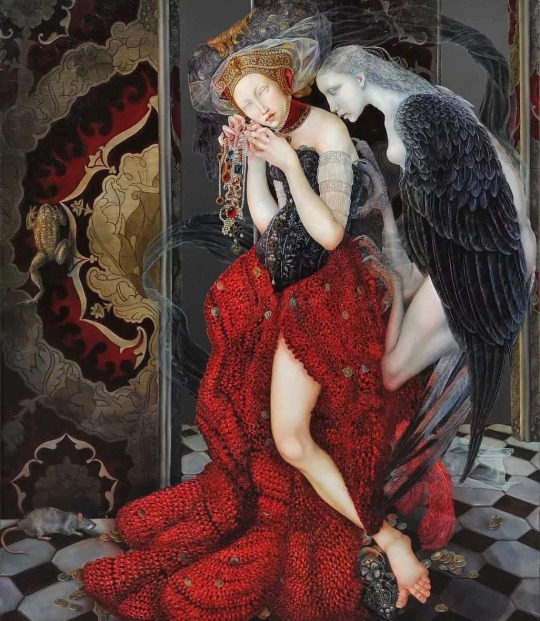
Joanna Chrobak (PL, b.1968), The Greed [Chciwość] 2019, Oil on anvas,
130 cm x 110 cm
www.joannachrobak.pl
Joanna Chrobak is a Polish Postwar & Contemporary artist who was born in 1968. via mutualart @abwwia
"Joanna Chrobak's pale, androgynous subjects strike mystical poses, like deities from another world. They are crowned and surrounded by dream symbols, and wordlessly" via cristinafaleroni
#JoannaChrobak #Sztukakobiet #PalianShow #womensart #PolishFemaleArtist #spiritual #PolishWomenArtists #spiritualart #mysticart
27 notes
·
View notes
Text
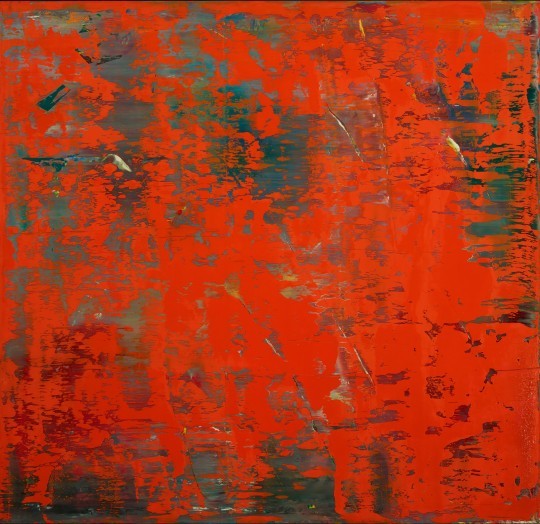
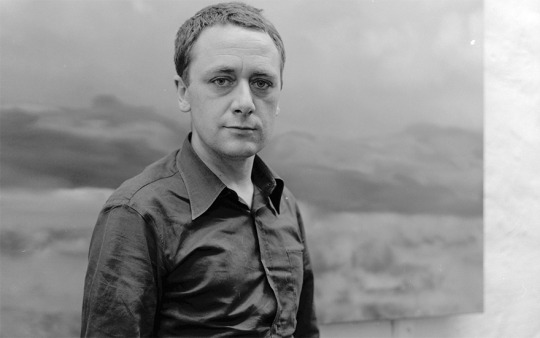
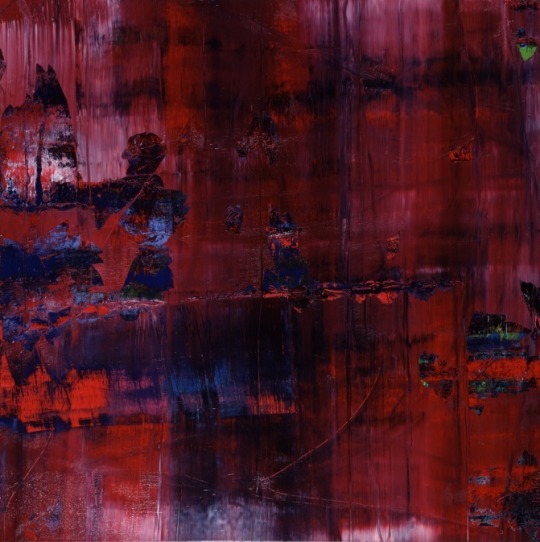

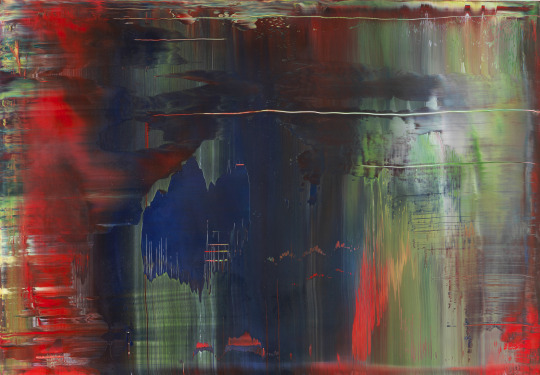



Gerhard Richter was born in 1932 in Dresden, Germany, during the rise of the National Socialist German Workers' Party, or the Nazi Third Reich. Notably, some of Richter's relatives were directly involved in the Nazi movement, namely his father, a schoolteacher, and an uncle. Richter's mother, the daughter of a concert pianist, encouraged her son's early talent for draftsmanship. In 1948, at the age of 16, Richter quit his formal education and took up an apprenticeship as a set painter for the theater. The wake of war proved traumatic for Richter: two of his uncles had been killed in action, and his father had lost his employment. This family turmoil, coupled with the artist's early artistic training under postwar communist-driven ideology, eventually led Richter to seek his creative inspiration in nature over any political or religious affairs or philosophies.
Beginning in 1951, Richter studied at the Kunstakademie, Dresden, where he painted murals and political banners commissioned by state-owned businesses. During this time, the East German communist regime imposed a Social Realist style on all practicing artists; this policy effectively turned art to the service of political propaganda. In keeping with this development, the government banned exhibitions of American Pop art and Fluxus. These circumstances severely limited Richter's fledgling artistic style, as he was instructed to paint only landscapes in a manner heavily informed by pastoral romanticism.
Richter married Marianne Eufinger in 1957, and the couple celebrated the birth of a daughter, Betty, in 1966. Two years later, during a visit to West Germany in 1959, Richter discovered the work of contemporary artists Jackson Pollock and Lucio Fontana. Pollock's uninhibited splashes of color across canvas had a profound impact on Richter, provoking him to reflect on his own artistic ideology. Indeed, Richter began to question how a realist style did not seem to capture the energy, sense of truth, and spirit of artistic liberation that he observed in the abstract work of his American and European contemporaries. Supposedly "realistic", his work seemed to fail to reflect the underlying, tumultuous nature of reality itself.
In 1961, just prior to the government's official completion of the Berlin Wall, Richter moved to Düsseldorf. Once again enrolling at the local Kunstakademie, Richter intended to work in a more uninhibited, avant-garde manner; in the process of rethinking his approach to art making, he purposely destroyed many of his early paintings from the 1950s and the 1960s.
Continue reading https://www.theartstory.org/artist/richter-gerhard/
60 notes
·
View notes
Photo
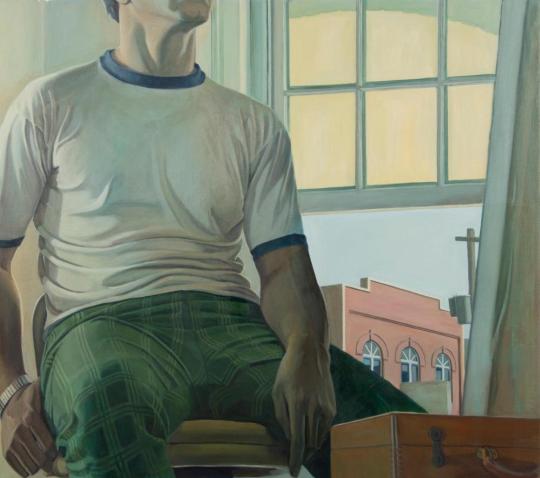
Henry Ransom / Self-Portrait (1974)
Henry Cleveland Ransom, Jr. is a Postwar & Contemporary artist who was born in 1942.
103 notes
·
View notes
Text
Have been reading a lot at work and surprised myself again, in the sense that. If I split the project into parts it might actually be workable:
On the locus of the "I": cogito/reason, memory, Geist, psyche
On the invention of nation + public; philosophical geography; "civilization"; assimilation
On the conceptual, practical/legal, + discursive tensions between individual & collective a) self-determination, b) representation + expression, c) memory, d) psyche
On aesthetic empathy, Kunstwellen, "Empathy & Abstraction," Jung, early psychoanalysis, Bergsonian metaphysics & anthropology, ethnography, folklore, "authenticity" (circle back to "civilization," nation-building, etc.)
THE INTERWAR AESTHETIC/SOCIOPOLITICAL CONFLICT: REPRESENTATION VS. ABSTRACTION
WITHIN ABSTRACTION CAMP: Paris avant-garde (and Polish/French overlap); THE BIG TL;DR--HOW JUNG, BERGSON, VIENNA SECESSION ART CRITICS, IDEA OF NATIONAL GEIST (IMMUTABLE), IDEA OF NATIONAL CONSCIOUSNESS (PSYCHOANALYTIC SENSE), SYMBOLISM, "CIVILIZATION," AND FEAR OF ABSTRACTION AS TRANSCENDING REPRESENTATION'S INEVITABLE SIGNIFIERS OF DIFFERENCE (RACE SCIENCE IS ALSO HERE) COME TOGETHER: THE BELIEF THAT ABSTRACT ART CAN BETRAY IN ITS USE OF COLOR & FORM THE ARTIST'S SUBCONSCIOUS FOREIGNNESS, UNCIVILIZED NATURE, ETC., & THE BELIEF THAT ONE'S INDIVIDUAL (SUB)CONSCIOUS IS A) IMMUTABLE/ESSENTIAL, B) ETHNO-NATIONAL IN CHARACTER. This was expressed mostly about Jews
In Poland, during the interwar period, these aesthetic discourses re: abstract art corresponded to what were, imo, related debates: one about the Polish language (another variation on content vs. form, representation vs. abstraction, and How To Clock Jews & Ukrainians When They Speak Perfect Unaccented Polish), one about the "right to choose one's nationality," i.e., assimilation and self-determination
CODA: "MY OTHER HOMELAND IS THE IDEA OF EUROPE" - on Stefania, the postwar world order, the emergence of trauma theory, the psychoanalytic turn in historiography, and the contemporary prominence of memory studies, collective memory, collective consciousness, collective guilt, collective national affects, and the politics of commemoration - how "memory culture" can be seen as an encounter between the post-Enlightenment, fin-de-siecle Idea of Europe and the post-WWII, post-imperial Idea of Europe - the nation as collective subject, imbued with reason + will (self-determination), memory (the basis for identity, pro/contra Hume), consciousness in the psychoanalytic sense (experiences via historical process trauma, guilt, even return of the repressed). The staging of history as a psychoanalytic working-through of memory and the transformation of that staging into ritual commemoration become, by extension, constitutive of "civilization" (the nation as civilized person & LITERALLY analysand!!!!!!)
I have to learn German and French, unfortunately
10 notes
·
View notes
Text
Free Virtual Museum Tours | MasterList
1. J Paul Getty Museum, Los Angeles
With more than 6,000 years worth of creative treasures, the Getty is one of the best places for art on the west coast of the US. Go from neolithic clay figures to Van Gogh’s Irises and Renoir’s La Promenade – just two of many artworks that feature in the virtual tour. As with several of our selection, Google Arts and Culture offers a “museum view” tool to look inside gallery spaces, with clickable artworks presenting further information. The Getty’s sunny sculpture plaza and garden terrace are worth adding to your digital trip, via another viewing platform, Xplorit. (https://artsandculture.google.com/partner/the-j-paul-getty-museum?hl=en) getty.edu
2. Vatican Museums, Rome
Soaring vaulted ceilings, intricate murals and tapestries, the Vatican’s museums are creatively rich sites. Don’t forget to look up when exploring the seven spaces in the museum’s virtual tour (http://www.museivaticani.va/content/museivaticani/en/collezioni/musei/tour-virtuali-elenco.1.html), to gawp at a series of 360-degree images, including the Sistine Chapel. Wander around the rest of Vatican City with a You Visit tour that takes in Saint Peter’s Basilica and Square, complete with a tour guide narrating each interactive space. museivaticani.va
3. Guggenheim, Bilbao
Frank Gehry’s sculptured titanium and steel building, on the banks of the Nervión River, is one of the world’s most distinctive art spaces. The interactive tour (https://artsandculture.google.com/partner/guggenheim-bilbao) takes viewers around its collection of postwar American and European painting and sculpture – Rothko, Holzer, Koons, Kapoor – and even down between the weathered curves of Serra’s Matter of Time (turn left at the entrance).
guggenheim-bilbao.eus
https://www.guggenheim-bilbao.eus/en/digital-experiences
4. Natural History Museum, London
From the diplodocus to the dodo, botany to butterflies, giant crystals to specimens in jars … the Natural History Museum’s vast collection has long been a favourite of both Londoners and tourists. Get lost in the corridors and gallery spaces – one treat is Dippy the dino, who despite recently going on tour still makes an appearance in the entrance hall in this interactive online guide (https://artsandculture.google.com/partner/natural-history-museum) .
nhm.ac.uk
5. Rijksmuseum, Amsterdam
This grand museum has a vast collection of art and historical objects across 80 galleries. A 10-year renovation project was completed in 2013, transforming the space and combining elements of 19th-century grandeur with modern lighting and a new glass-roofed atrium. The interactive tour (https://artsandculture.google.com/partner/rijksmuseum) helps viewers get up close to every brush stroke by Vermeer, Rembrandt and other Dutch masters while exploring the Great Hall and beyond. rijksmuseum.nl
6. National Museum of Modern and Contemporary Art, South Korea
There are several sites making up this museum: the main gallery in Gwacheon and branches in Deoksugung, Seoul and Cheongju. The virtual tours (https://artsandculture.google.com/partner/national-museum-of-modern-and-contemporary-art-korea) explore an inspiring mix of print, design, sculpture, photography, new media and other large-scale installations. From Joseph Beuys to Warhol and Nam June Paik, the collection includes an international lineup of established artists, contemporary Korean artworks and emerging names. mmca.go.kr
7. Musée d’Orsay, Paris
In the former Gare d’Orsay, a Paris railway station and hotel, the musée is home to Cézanne, Monet and other French masters. Under a 138m-long curved glass roof, sits the largest collection of impressionist and post-Impressionist works in the world. The virtual tour (https://artsandculture.google.com/partner/musee-dorsay-paris) also includes an online exhibition charting the history of the building. And over on Tourist Tube there’s a 360-degree view of the magnificent exterior. m.musee-orsay.fr
8. British Museum, London
There are 3,212 panes of glass in the domed ceiling of the British Museum’s Great Court, and no two are the same – and the 360-degree view in this virtual tour (https://artsandculture.google.com/partner/the-british-museum) lets viewers examine each and every one. Beyond this magnificent space, viewers can find the Rosetta Stone, Egyptian mummies and other ancient wonders. The museum’s interactive infographic platform, History Connected, goes into further depth of various objects with curators, along a timeline. britishmuseum.org
9. MASP, São Paulo, Brazil
The Museu de Arte de São Paulo has one of the broadest historical collections available to view via its virtual gallery platform (https://artsandculture.google.com/partner/masp?hl=en) , spanning from the 14th to 20th centuries. Paintings appear suspended in the air around the open-plan space, on glass panels or “crystal easels” as the museum calls them. There’s also a temporary retrospective exhibition by Brazilian pop artist Teresinha Soares beside the building’s statement red staircase. The glass and red-beam structure, built in 1968, is worth a look from the outside too, via Google Street View.
masp.org.br
10. National Gallery, London
A backdrop to London’s four lions in Trafalgar Square, the National is home to 2,300 publicly-owned paintings, watercolours, drawings and other European art from the 13th to the mid-20th century. There are seven exhibition spaces of Renaissance art and the Central Hall to explore in its 360-view virtual touring pages (https://www.nationalgallery.org.uk/visiting/virtual-tours/google-virtual-tour) , from portraits to large dramatic altarpieces. nationalgallery.org.uk
11. National Gallery of Art, Washington, D.C.
This famous American art museum features two online exhibits (https://artsandculture.google.com/partner/national-gallery-of-art-washington-dc?hl=en) through Google. The first is an exhibit of American fashion from 1740 to 1895, including many renderings of clothes from the colonial and Revolutionary eras. The second is a collection of works from Dutch baroque painter Johannes Vermeer.
12. Pergamon Museum, Berlin
As one of Germany's largest museums, Pergamon has a lot to offer — even if you can't physically be there (https://artsandculture.google.com/partner/pergamonmuseum-staatliche-museen-zu-berlin?hl=en) . This historical museum is home to plenty of ancient artifacts including the Ishtar Gate of Babylon and, of course, the Pergamon Altar.
13. Van Gogh Museum, Amsterdam
Anyone who's a fan of this tragic, ingenious painter can see his works up close (or, almost up close) (https://artsandculture.google.com/partner/van-gogh-museum?hl=en) by virtually visiting this museum, home to the largest collection of artworks by Vincent van Gogh, including more than 200 paintings, 500 drawings, and 750 personal letters.
14. Uffizi Gallery, Florence
This less well-known gallery houses the art collection of one of Florence's most famous families, the de' Medicis. The building was designed by Giorgio Vasari in 1560 specifically for Cosimo I de' Medici, but anyone can wander its halls from anywhere in the world (https://artsandculture.google.com/partner/uffizi-gallery?hl=en) .
15. National Museum of Anthropology, Mexico City
Built in 1964, this museum is dedicated to the archaeology and history of Mexico's pre-Hispanic heritage. There are 22 exhibit rooms (https://artsandculture.google.com/asset/the-national-museum-of-anthropology-mexico-city-ziko-van-dijk-wikimedia-commons/bAGSHRdlzSRcdQ?hl=en) filled with ancient artifacts, including some from the Maya civilization. Not all popular art museums and galleries are included in Google Arts & Culture's collection, but some have taken it upon themselves to offer online visits. For example, the Louvre offers virtual tours on its website.
To see more of Google Arts & Culture's collection of museums, visit its website. There are thousands of museum Street Views (https://artsandculture.google.com/search/streetview?hl=en) on Google as well. Google Arts & Culture also has an online experience for exploring famous historic and cultural heritage sites.
16. The Louvre
The Louvre may be closed, but you can still access its many treasures online. The French museum’s virtual tour takes you to some of its galleries, including into the basement ruins of the building’s original moat, which dates back to 1190. Don’t miss the Egyptian antiquities, where you can learn more about the pharaonic period. While the entire museum isn’t available as a tour, much of the collection is available as images on their website, so you and the kids can search for the most memorable works, including the Mona Lisa.
Tour The Louvre (https://www.louvre.fr/en/online-tours)
17. Smithsonian National Museum of Natural History
Take yourself on a tour of the Smithsonian National Museum of Natural History, whether it’s through the temporary exhibitions or the permanent collection. Along the way, check out dinosaur skeletons, animals from around the globe and even past exhibits that are no longer on display in reality. It’s a great way to keep your kids learning about the world around them even when they can’t be in school, and there are plenty of follow-up activities or readings you can do after the tour. While you’re there, stop by the Smithsonian Castle and the Hirshhorn Sculpture Garden, both of which have adjoining virtual tours. (https://naturalhistory.si.edu/visit/virtual-tour)
18. Easter Island
Take things outside to Easter Island, where Google has created a virtual tour of the island’s famed statues. There’s also a short video of the island and its massive ancient creations, which could make for a good opportunity to discuss world geography with your kids. (https://artsandculture.google.com/story/4wXhfs-0ooroMQ?hl=en)
19. Monterey Bay Aquarium
Who doesn’t want to look at peaceful videos of undersea life when they need a break from reality? The Monterey Bay Aquarium’s live web cams will delight both you and your young ones, especially the adorable penguin cam. To find something soothing, watch the hypnotizing moon jelly cam or the kelp forest cam, which showcases leopard sharks moving among the kelp. When the live cams aren’t running (they operate during specific hours), there are pre-recorded videos to fill in. (https://www.montereybayaquarium.org/animals/live-cams)
20. NASA Glenn Research Center
Take a virtual tour of the NASA Glenn Research Center or the Space Telescope Operations Control Center, which houses the Hubble Telescope. At NASA Glenn, delve into the ballistics impact lab or the supersonic wind tunnel, which could, of course, lead to a discussion about physics that you might not be that equipped to have. Don’t worry, NASA has a lot of stuff online, making it a great resource during this time at home. (https://www.nasa.gov/glennvirtualtours)
Sources:
Andrea Romano Updated April 27, 2022 (www.travelandleisure.com)
Antonia Wilson Mon 23 Mar 2020 17.15 GMT (www.theguardian.com)
Emily Zemler avr.. 8, 2020 (www.purewow.com)
#museum#masterlist#exhibit#exhibition#free#tour#online#virtual#list#art#science#culture#informations
79 notes
·
View notes
Text
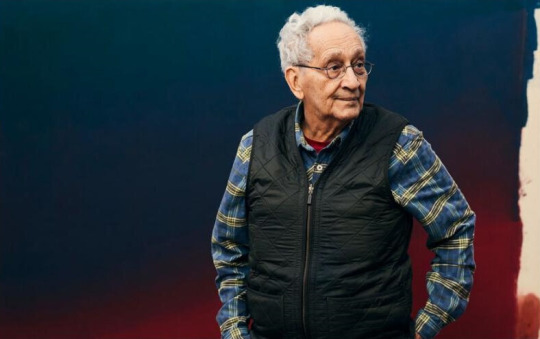
Frank Stella photographed at his home in front of Jules Olitski's 1964 work Hot Ticket
Barrett White, Executive Deputy Chairman, Post-War and Contemporary Art, New York, remarked: “Frank Stella is unequivocally one of the great artists of our time. He is an artistic polymath—an expert on Renaissance Art, a teacher of architecture, a trailblazing painter, a brilliant printmaker and an innovative sculptor. The selection that we present here illustrates one of Stella’s lesser known facets: his passion as a collector. Continuum: Select Works from Frank Stella’s Personal Collection is a group of works that have influenced Stella’s life and creative process. They are personal relics from his private life—gifts from artists and a major acquisition made as a celebration of his son’s birth—as well as landmark examples by Stella himself. What sets this selection apart is its expansive range, stretching across artistic movements and more than half of a millennium, from Northern Renaissance portraiture, to Surrealism, and on to the work of his peers, this group goes to show how the course of art history has informed Stella’s revolutionary practice over the course of his career.”
Stella remains a voracious student whose interests span many different periods and movements. From the work of the Old Masters, including painter Jan Sanders van Hemessen, the Surrealism of Joan Miró, the early works of David Hockney, to the paintings of peers such as Helen Frankenthaler, he has specifically sought out works by artists that excite and inspire him, acquiring many examples for his own personal collection. Beginning with his iconic Black Paintings in the late 1950s, and followed by his bold geometric canvases of the late 1960s and early 19790s, Stella challenged the accepted traditions of art history, including how to deal with the inherent contradictions of two-dimensional painting. But his work has always been rooted in a deep knowledge and appreciation of what had gone before him. His combination of scholarship and artistic ability produced a dialogue that would come to define postwar art history and secure Frank Stella’s place as one of the most influential artists of his generation.
Courtesy Alain Truong
8 notes
·
View notes
Text
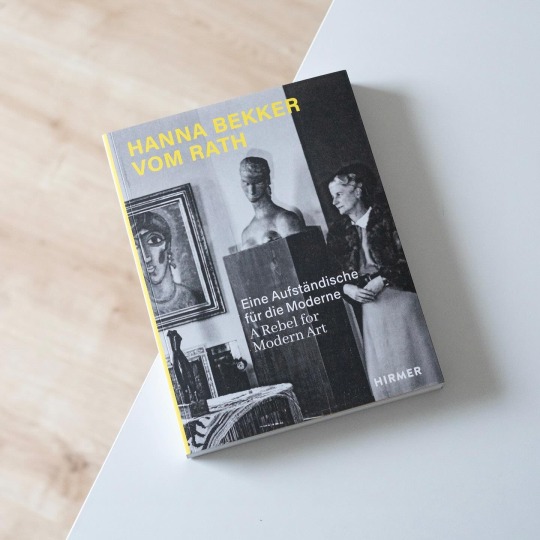
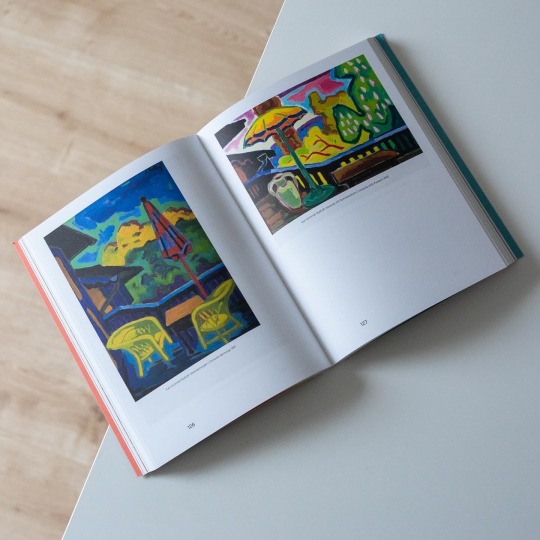
At a time when women were largely confined to household and parenting Hanna Bekker vom Rath (1893-1983) pursued a different path: born into a wealthy, liberal family then Hanna vom Rath neither wanted to fulfill representative functions nor did she want to live the life a traditional housewife. Instead she wanted to become an artists and took painting and drawing lessons with Ottilie Roederstein, Ida Kerkovius and Adolf Hoelzl. But although her dream of a full-time artistic career never materialized she devoted her life to art: at the „Blue House“ in Wiesbaden, the family seat of her, Paul Bekker and their children, she displayed her growing collection of works by Heckel, Kirchner, Lehmbruck or Schmidt-Rotfluff. Together with Alexej von Jawlensky, whom she had befriended around 1926, Schmidt-Rotluff became Bekker's house artist and spent many summer weeks in the „Blue House“, especially after the Nazis seized power in 1933. During these years and despite the danger of being denunciated Bekker began to support „her“ artists by organizing secret exhibitions in her house as well as her apartment in Berlin: her goal was to secure the artists’ economic base by selling their „degenerate“ artworks to progressive collectors. Among the exhibited artists verifiably were Erich Heckel, Willy Baumeister, Ida Kerkovius, Ernst Wilhelm Nay and Karl Schmidt-Rottluff while visitors included sculptor Georg Kolbe, the founding director of the Brücke Museum Leopold Reidemeister as well as Ernst Gosebruch, the forcibly removed former director of the Folkwang Museum. These exhibitions, hosted under precarious conditions, nevertheless lay the foundation for Bekker’s postwar Kunstkabinett in Frankfurt/Main where she showed prewar as well as contemporary art.
Right now and up until 16 June the Brücke Museum in Berlin with „Hanna Bekker vom Rath. A Rebel for Modern Art“ devotes a comprehensive exhibition to her pioneering work and the artists she collected and represented. Alongside it the Hirmer Verlag published the present catalogue which provides a concise overview of Bekker’s many activities: besides featuring a beautiful spreads of her legendary residence and her artworks the included essays elaborate her biography and artist network, her clandestine exhibitions during wartime as well as her women artists network.
This independent and exciting life of hers is very insightfully elaborated and beautifully illustrated in the catalogue that accordingly is highly recommended!
#hanna bekker vom rath#hirmer verlag#art history#art book#exhibition catalogue#gallerist#expressionism#modern art#book
7 notes
·
View notes
Text

JC Götting (Jean-Claude Götting) / b. 1963 French Postwar & Contemporary artist
72 notes
·
View notes